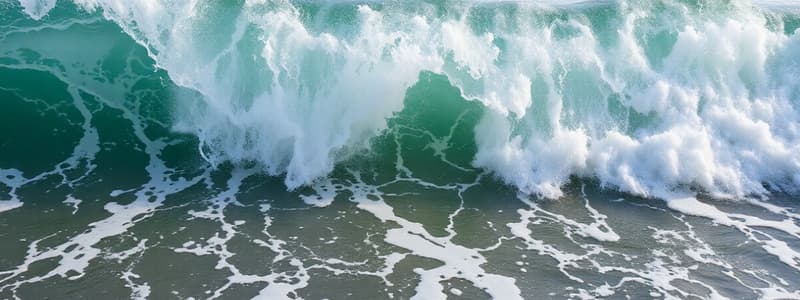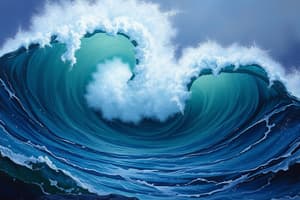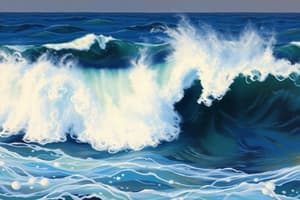Podcast
Questions and Answers
Which factor does not directly influence the intensity of a wave?
Which factor does not directly influence the intensity of a wave?
- Wind duration
- Fetch
- Water depth (correct)
- Wind strength
What is the primary motion of water particles as a wave passes through the water?
What is the primary motion of water particles as a wave passes through the water?
- Vertical oscillation
- Circular motion (correct)
- Back and forth motion
- Linear motion in the direction of the wave
What is the correct order of wave behavior as it approaches the coast?
What is the correct order of wave behavior as it approaches the coast?
- Contact with sea bed → circular motion → increased friction → breaking
- Circular motion → contact with the seabed → increased friction → breaking (correct)
- Increased friction → circular motion → contact with sea bed → breaking wave
- Circular motion → contact with sea bed → increased friction → breaking → contact with the sea bed
What is fetch in the context of wave formation?
What is fetch in the context of wave formation?
What is the relationship between wind strength and wave size?
What is the relationship between wind strength and wave size?
What determines if a wave is constructive or destructive?
What determines if a wave is constructive or destructive?
How does a destructive wave impact the beach?
How does a destructive wave impact the beach?
What is the main cause of tides on Earth?
What is the main cause of tides on Earth?
How frequently do high tides occur?
How frequently do high tides occur?
Why are there typically two high tides per day?
Why are there typically two high tides per day?
What is characteristic of constructive waves?
What is characteristic of constructive waves?
What causes low tides?
What causes low tides?
What happens to the water level on the beach during high tide?
What happens to the water level on the beach during high tide?
Flashcards
Fetch in wave formation
Fetch in wave formation
The horizontal distance over which wind blows without interruption, creating waves.
Wind Duration in wave formation
Wind Duration in wave formation
The length of time wind blows consistently, creating waves.
Wind Strength in wave formation
Wind Strength in wave formation
The force of the wind blowing, determining the size of waves.
What is an ocean wave?
What is an ocean wave?
Signup and view all the flashcards
What happens when waves reach a coast?
What happens when waves reach a coast?
Signup and view all the flashcards
Breaking Wave
Breaking Wave
Signup and view all the flashcards
Uprush
Uprush
Signup and view all the flashcards
Backwash
Backwash
Signup and view all the flashcards
Constructive Wave
Constructive Wave
Signup and view all the flashcards
Destructive Wave
Destructive Wave
Signup and view all the flashcards
Tides
Tides
Signup and view all the flashcards
High Tide
High Tide
Signup and view all the flashcards
Low Tide
Low Tide
Signup and view all the flashcards
Study Notes
Wave Formation and Intensity
- Waves are a regular pattern of motion, and movement of energy through water.
- Wind blowing on the surface of water creates waves at the air-water interface.
- Water particles move in a circular motion, transferring energy. Water itself is not carried away by the wave.
Factors Affecting Wave Intensity
- Fetch: The distance wind blows over open water without interruption.
- Wind Duration: How long the wind blows.
- Wind Strength: Stronger winds create bigger waves.
Wave Interaction with Coastlines
-
As waves approach the shore, friction slows the base of the wave.
-
This changes the orbit of water particles to elliptical.
-
Waves break when the top of the wave overtakes the base.
-
This is caused by friction with the sea bed.
-
The process creates a breaking wave.
-
The sequence is: waves travel in circular motion, waves encounter the coast and sea bed, the water exerts a strong frictional force on the base of the wave, increased friction as waves approach the coast, and wave breaks over just before the coast.
Types of Wave Interaction
-
Constructive Waves: Have a stronger uprush than backwash.
- This deposits material on the beach.
- Creates gentle slopes and low-frequency waves.
-
Destructive Waves: Have stronger backwash than uprush.
- Erodes material from the beach.
- Creates steeper slopes and are generated from large storms with high-frequency waves.
-
Swash: The movement of water up the beach.
-
Backwash: The movement of water down the beach.
Formation of Tides
- Tides are the regular rise and fall of sea level.
- High tide occurs when water levels rise on the beach.
- Low tide occurs when water levels fall on the beach.
- Primary cause is the moon's gravity.
Factors Causing High and Low Tides
- The Moon's gravity creates bulges of water on both sides of the Earth.
- Earth's rotation carries locations into and out of these bulges causing high and low tides.
Frequency of Tides
- High tides occur about every 12.5 hours.
- Two high tides and two low tides happen every 24 hours and 50 minutes.
Studying That Suits You
Use AI to generate personalized quizzes and flashcards to suit your learning preferences.




